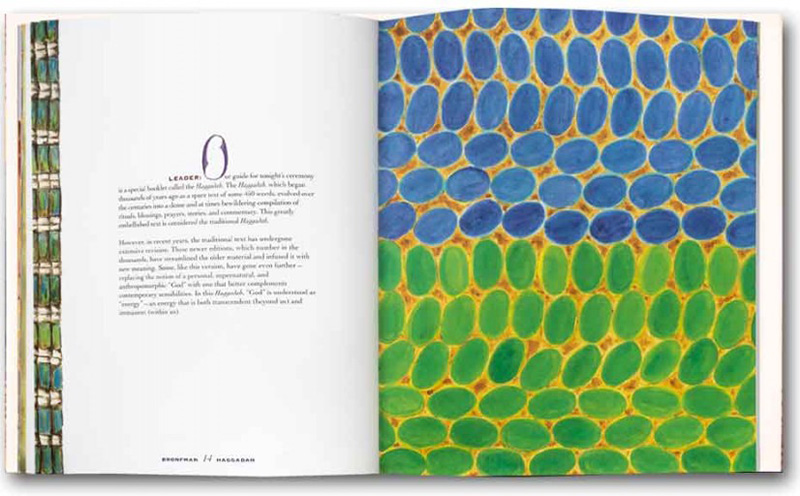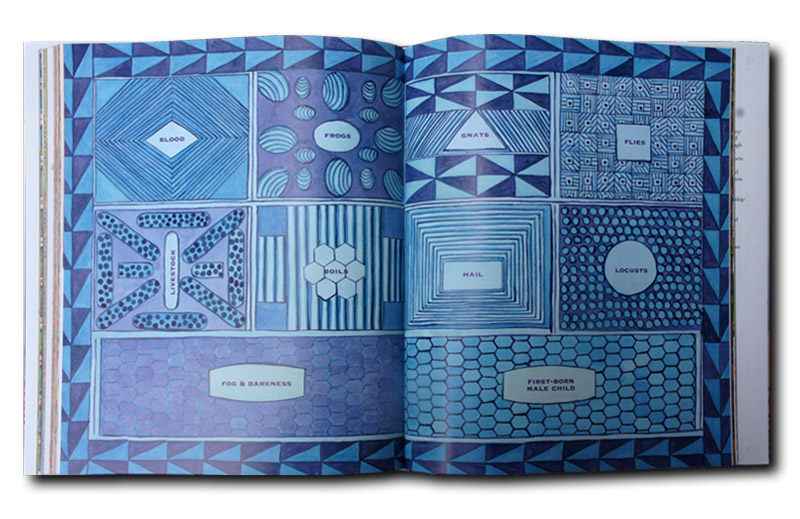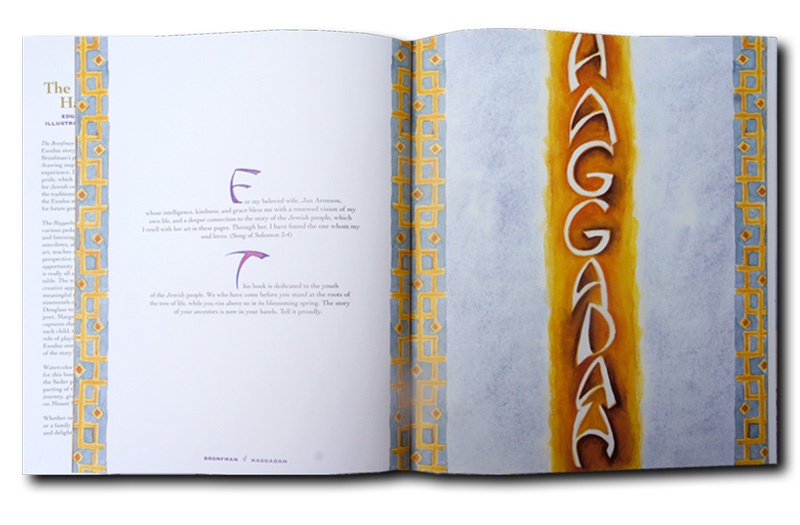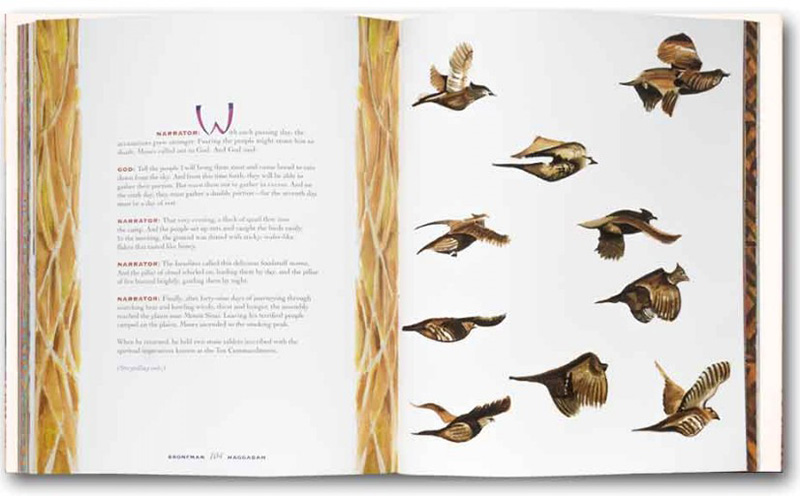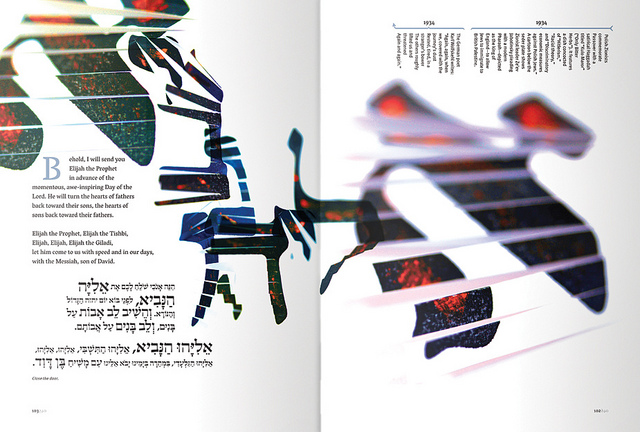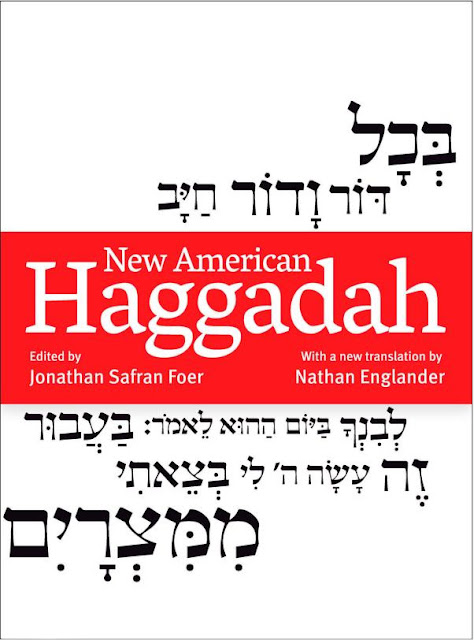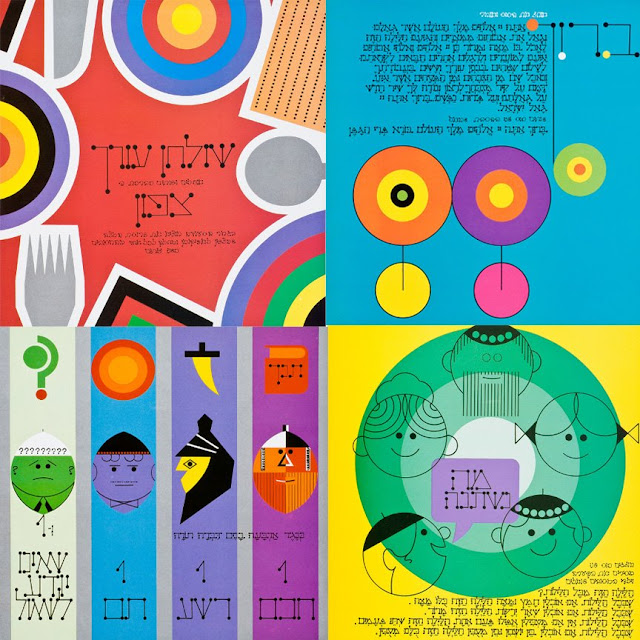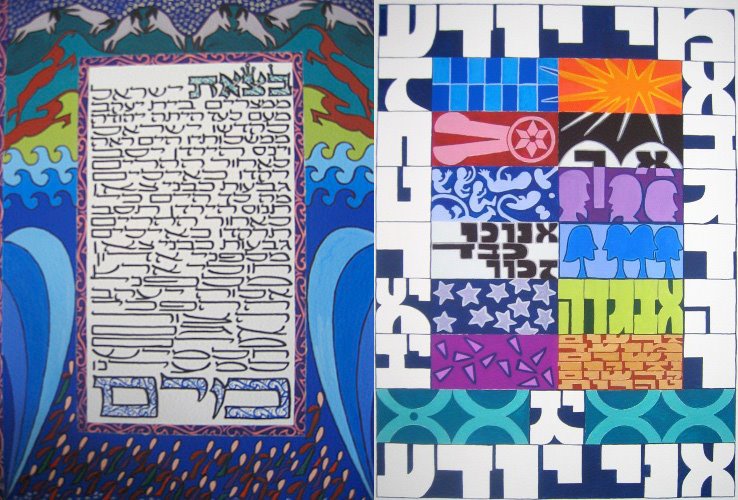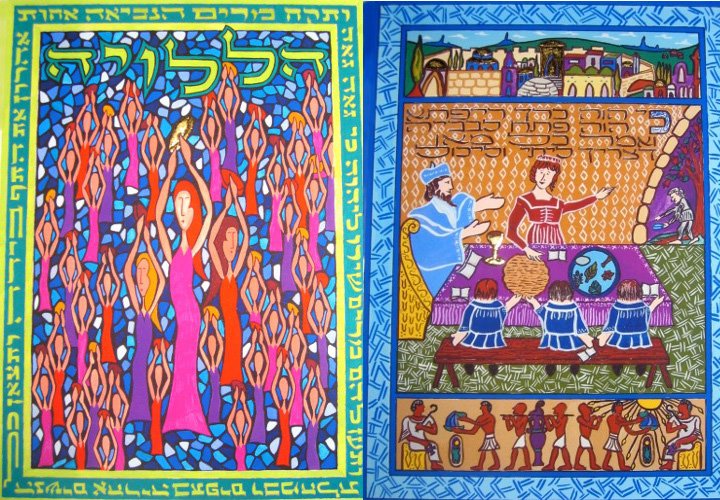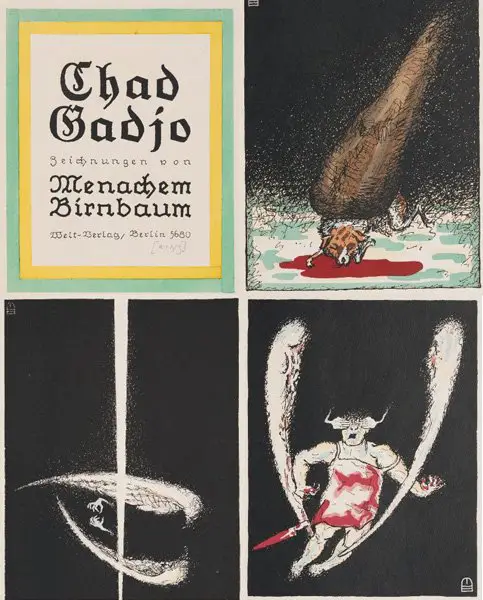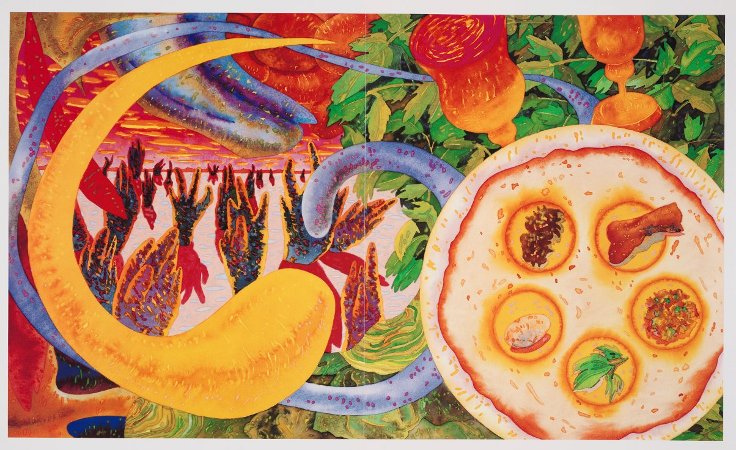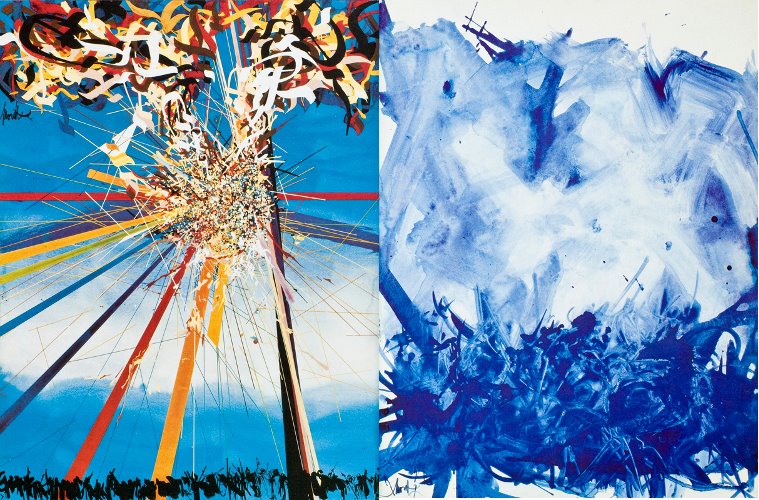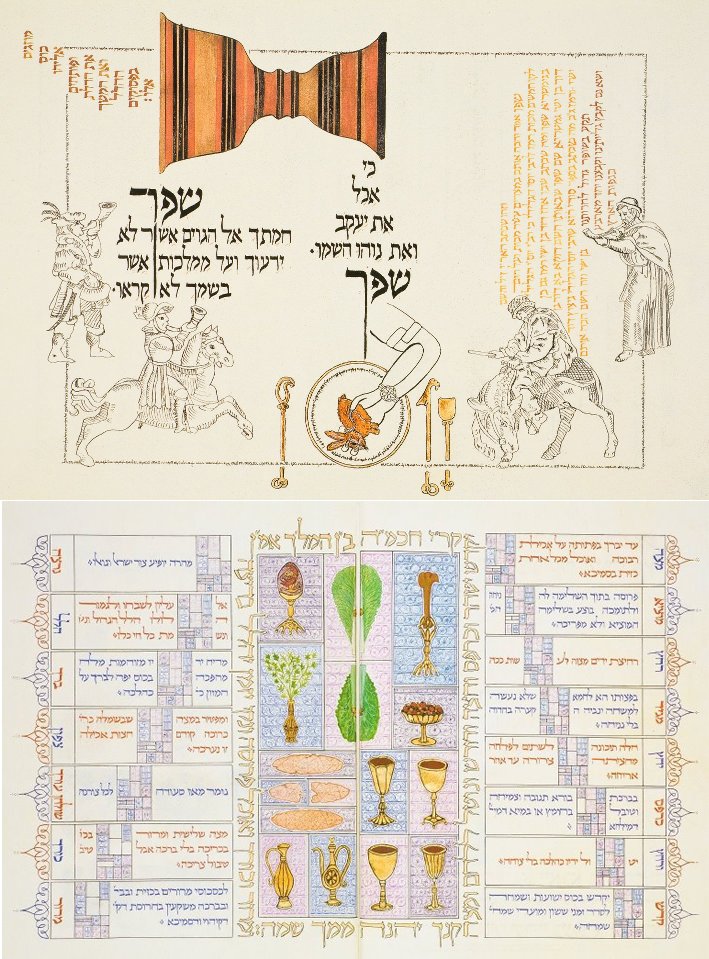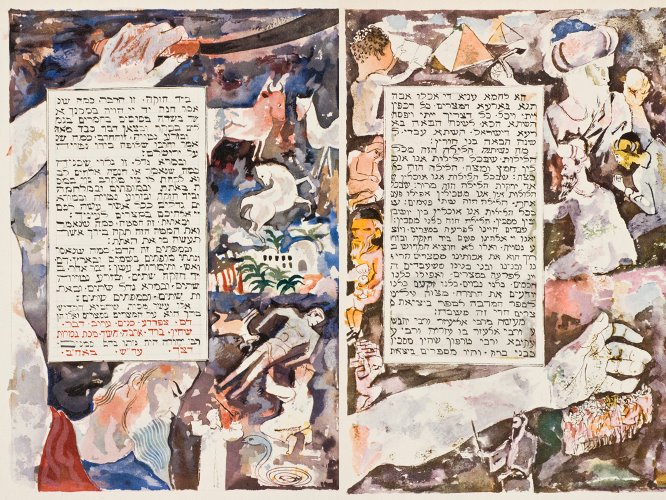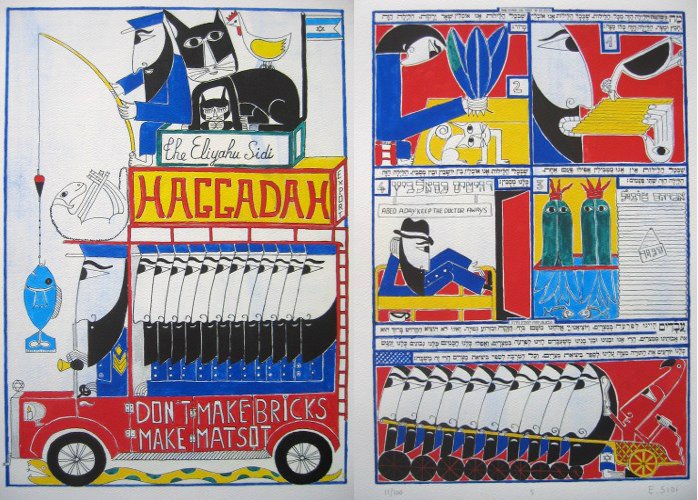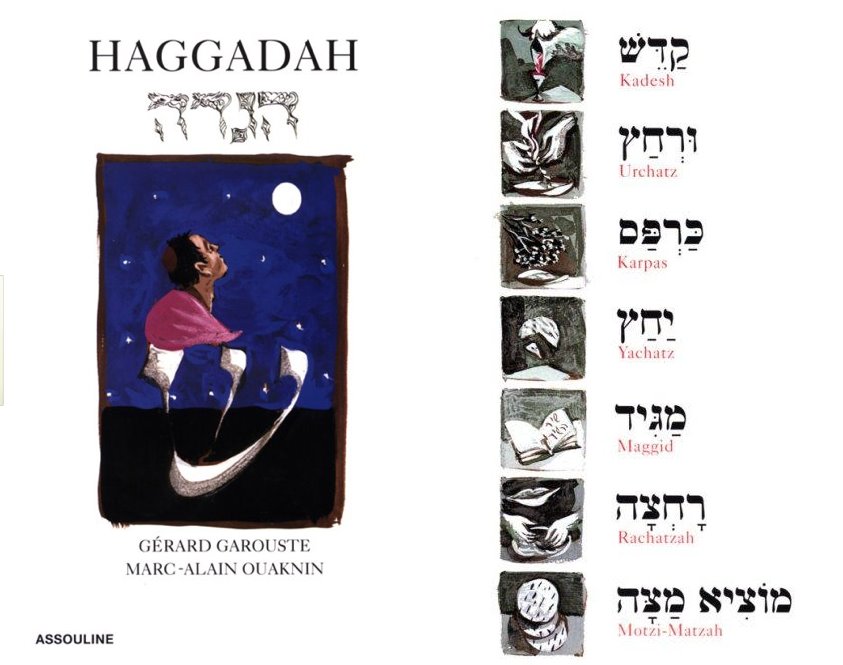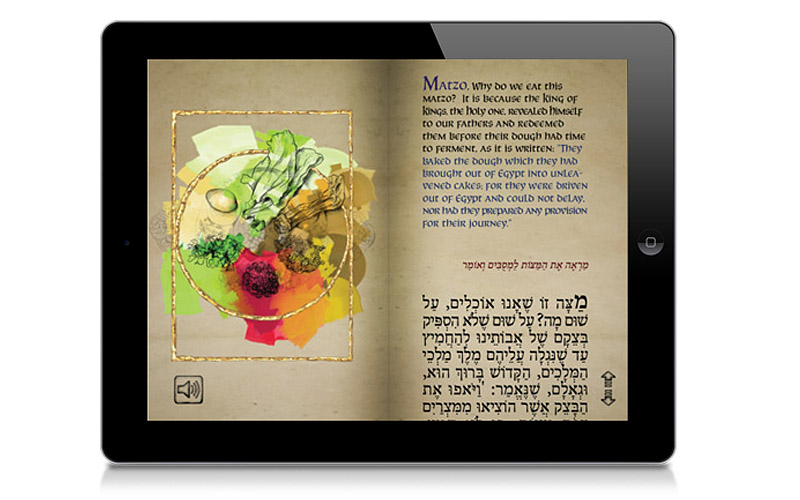On the first night of Passover, a Seder dinner will take place in most observant homes where children and adults alike will be reading from their Haggadot (that’s the plural of Haggadah). So what is Passover? For you non MOTs, you can learn more here.
22 Modern Art Haggadahs For Passover

What is a Haggadah?
A compilation of biblical passages, prayers, hymns, and rabbinic literature meant to be read during the Passover Seder, a ceremonial meal held in Jewish homes to commemorate the Israelite redemption from Egypt in biblical times.
Growing up in my household, you had the choice to read from the mimeographed or ditto machine duplicated and bound Haggadah (that still smelled like carbon paper) or the incredibly boring text laden one handed out by the local synagogue- complete with drawings of stick figures.
But since then, there have been some beautifully illustrated versions created by both well-known artists like Russian Constructivist El Lissitzky and Leonard Baskin as well as lesser known contemporary artists like Rabbi Matthew L. Berkowitz and papercut artist Archie Granot.
Here are several images from various modern art Haggadot for you (many of which are courtesy of Yale University’s Library and Judaica Collection). Images such as The Seder table, The Four Sons, The Red Sea, the Plagues, Manna From Heaven, Had Gadya, The Exodus, burning bushes, lambs blood, Pharaohs and more are diversely illustrated by these respected artists. Take a look – jewish or not, if you like art, you will most likely appreciate these.
Since this is an updated post, I’m going to begin with the two newest additions, published this year and last.
Modern Art Haggadahs
1. The Bronfman Haggadah
A revolutionary Haggadah for the 21st century, The Bronfman Haggadah, just published in February of 2013,is a provocative and stunningly visual reinterpretation of the Passover story. A collaboration between world-renowned philanthropist and Jewish leader Edgar M. Bronfman and acclaimed artist Jan Aronson, it tells of the Exodus, the Jews’ dramatic journey from slavery to freedom, in a way that will captivate generations to come.
Aronson’s bold and brilliant watercolor paintings heighten the text and amplify a story that is crucial to the Jewish narrative of Identity. These luminous images— both abstract and figurative—artfully illustrate the Seder plate’s symbolic foods, the parting of the Red Sea, the forty-year journey through the desert, the giving of the Ten Commandments on Mount Sinai, and other events pivotal to Passover.

Buy The Bronfman Haggadah here
2. The New American Haggadah by Jonathan Safran Foer with typography design by Oded Ezer
Jonathan Safran Foer has orchestrated a new way of experiencing and understanding one of our oldest, most timeless, and sacred stories, with a new translation of the traditional text by Nathan Englander and provocative commentary by major Jewish writers and thinkers Jeffrey Goldberg, Lemony Snicket, Rebecca Newberger Goldstein, and Nathaniel Deutsch. Ravishingly designed and illustrated by the acclaimed Israeli artist and calligrapher Oded Ezer, New American Haggadah is an utterly unique and absorbing prayer book, the first of its kind, that brings together some of the preeminent voices of our time.
Hardcover, 160 pages, 8.2 x 0.9 x 11 inches
Buy the New American Haggadah here
3. The Yaakov Agam Haggadah
Yaakov Agam created illustrations for the Haggadah that can be described as geometric abstractions. Though Agam was raised in a strictly observant home by a father who was a rabbi and a mystic, Agam’s art for his Hagadah is light and playful. Using vibrant colors, stick letters, and geometric shapes, he continues the great tradition of Haggadah illustration while adding a flare that is uniquely his own.
Illustrations and calligraphy: Yaakov Agam (1928- ) Jerusalem: Gefen Publishing House, 1993, Images copyright © Yaakov Agam.
4. The Leonard Baskin Haggadah

Most probably it was Baskin’s early Jewish upbringing and education and his concern with social causes that attracted him to illustrating the Haggadah. Much like Ben Shahn, he worked in water colors and did his own calligraphy. Indeed art and text in Baskin’s Haggadah illustrations become inseparable.
A Passover Haggadah. The New Union Haggadah. Edited by Herbert Bronstein; drawings by Leonard Baskin. New York: Central Conference of American Rabbis [1974]. Images copyright © Central Conference of American Rabbis.
Now available in its second printing here.
5. The Matthew Berkowitz Haggadah
Passover Landscapes; Illuminations on the Exodus. Portfolio of 27 signed and numbered giclee prints, Haggadah and Book of Commentary by Matthew L. Berkowitz. Jerusalem: Nirtzah Editions, 2006.
Berkowitz is a rabbi whose current position is that of Senior Rabbinic Fellow in the Florida Regional Office of the Jewish Theological Seminary of America. Landscapes according to Berkowitz “convey the soul of the Passover experience.” It is “an expanse of scenery that can be seen in a single view. The seder imparts the breadth of Jewish experience, treating us to a panoramic view of Judaism through text and interpretation.” Of his work, Berkowitz writes, “I hope to challenge the ennui often experienced around the seder table and to recapture a spirit of creativity and spontaneity.” In addition to the images, the calligraphy is also by the artist.
Images copyright © Matthew Berkowitz.
What is Had Gadya (An Only Kid)?
Had Gadya is a folk song in Aramaic which concludes the Passover Haggadah. It is a relatively late addition to the Ashkenazi (Central European) Haggadah text and does not appear in the medieval editions. Much beloved by both young and old, it is about a goat purchased by father for two zuzim (coins). It is a playful, cumulative song which has, however, dark undertones.
6. Menachem Birnbaum’s Chad Godjo (Had Gadya)
Illustrated by Menachem Birnbaum (1893-1944), translation into German by Uriel Birnbaum. Berlin: Welt-Verlag, 1919.
The brothers Menachem and Uriel Birnbaum created imaginative and expressionistic books in post-World War I Germany and Austria. Both were artists and writers and they often collaborated on the books they produced. The illustrations that Menachem Birnbaum created for his edition of the Had Gadya reflect the trauma and pessimism of the post-war period in Germany and seem to foreshadow the horrors that were still to come. A portraitist and graphic artist, he worked as an art editor for Jewish journals and after World War I became the art director of two Jewish publishing houses. Compare Birnbaum’s interpretation to that of Lissitzky, whose Had Gadya illustrations are also in this exhibit, published in the same year. Both reflect on the cataclysmic events of their age but while Lissitzky seems to see a more hopeful future, Birnbaum sees only devastation.
7. Rose Ann Chasman’s Miniature Had Gadya, 1992
This delightful artistic rendition of the Had Gadya is in accordian format and is cut and collaged. It is hand written and cut and may be a unique piece. Image copyright © Chasman Family.
8. The Asher Kalderon Haggadah
Tel-Aviv, 2006. The Hebrew type and Headline letters were especially designed by the artist for this book. Limited edition of 396 copies.
Kalderon, an Israeli artist trained at the Bezalel School of Art in Jerusaelem, says this about his Haggadah illustrations “I have always loved the beauty of old Passover Haggadahs. They were splendid expressions of art, commissioned by wealthy families to beautify their Passover tables and as a legacy for generations to come. Now it was my turn to bring a new perspective to an old story. It was time for an innovative, unusual and beautiful Haggadah, to be treasured as a work of art, in the present and for generations to come. I used popular icons from ancient and universal mythology, all designed and decorated in my color scale and personal style. The extended format of the book was chosen to glorify the story of the Exodus.” Images copyright © Asher Kalderon.
9. The Offenbacher (Fritz Kredel) Haggadah
Fritz Kredel’s Haggadah was printed in two colors on Zerkall Bütten paper including 12 handcolored illustration pages by the artist. It also contains pages with musical notes. Though primarily in German, key passages also contain Hebrew and the text that appears in the illustrations is exclusively in Hebrew. The Haggadah represents a landmark in German-Jewish bookmaking in Weimar Germany.
Offenbacher Haggadah, 1927. Illustrations by Fritz Kredel (1900-1973). Offenbach am Maine: the printing house of Doctor Guggenheim. Printed in a limited edition of 300 copies.
10. El Lissitsky Had Gadya; An Only Kid
One of the great artists of the Russian Avant Garde of post-revolutionary Russia, Lissitzky studied together with Marc Chagall in the city of Vitebsk, Russia, with the Suprematist artist Kazimir Malevich. Lissitzky was interested in Jewish folk art and his illustrations for the Had Gadya reflect this interest. All the images depict the world of the small East European villages where the vast majority of Jews lived in the beginning of the 20th century. In Lissitzky’s artistic interpretation, the poem becomes an elegy for that world that had been decimated by war and revolution. The verses that surround each image are in Yiddish, the language of East European Jewry. Violence is the over-riding theme of the song and of the artist’s illustrations. The only hopeful image is that of the defeat of the Angel of Death by the divine hand. The fallen angel has a crown on its head and some take that to represent the recently deposed and executed Czar.
Illustrations and calligraphy by El (Eliezer) Lissitzky (1890-1941). Kiev, Tsentraler Bikher Lager, Kultur Lige, 1919.
11. Mikhail Magaril An Only Kid.
Mikhail Magaril has chosen the image of the arrival of the Messiah riding on his white donkey to illustrate the concluding stanza of the song. This is a stock image that appears in Christian iconography as well. Artists usually place it with the passage in the Hagadah that begins with: “Pour out your wrath on the nations that do not know You” or with the ending statement of the seder “Next year in Jerusalem.” Mikhail Magaril, however, has chosen to set his minimalist interpretation of this iconic image at the end of the Had Gadya. He thus reverses the nihilism inherent in the song, which is about death and destruction, and ends it on a note of hope for a better world to come. Monoprints by Mikhail Magaril. NewYork: Kuboaa Press, 1998.
Printed in an edition of 18 by Russell Maret. The text type is Centaur, designed by Bruce Rogers, printed on Rives de Lin paper. Images copyright © Mikhail Magaril.
12. The Victor Majzner Haggadah
In his introduction to his Haggadah, Victor Majzner discusses his connection to the text and to his adopted home, Australia. “Images from the Haggadah haunted my imagination. and finally I decided to produce my own interpretation of a complete contemporary Haggadah. It took four years to complete all the paintings and I feel that their implications will affect my work for the rest of my life.” “Australia has been my adopted home for over thirty years and it has become a place with which I relate intimately. Its landscape, scale, light and history have been major themes in my work and continue to inspire me.”
The Australian Haggadah Illustrations by Victor Majzner; calligraphic illustrations by Andrew Majzner, text calligraphy by Zelman Snir. Melbourne, Australia, 1992. Images copyright © Victor Majzner.
13. The Tamar Messer (Exodus) Haggadah
The Exodus Haggadah. Illustrations by Tamar Messer. Haifa, Israel: Gallery/Studio Tamar Messer, 2004. This number is 15 of a limited edition of 130 copies. Messer is an Israeli artist based in Haifa. She adopts a naïve style in her illustrations and her color palate is influenced by the bright and vivid light of the Israeli landscape. Images copyright © Tamar Messer.
14. The Raymond Moretti Haggadah
Moretti’s abstract art blends Modernism and Jewish Mysticism. The explosive energy of his art is barely contained by the limits of the page. Moretti’s illustrations do not necessarily appear in relation to a specific section of the Haggadah text but rather make dramatic statements concerning the Exodus story often using letters from the Hebrew alphabet as elements in their most abstract form.
Haggadah de la Cinquième coupe (The Haggadah of the 5th Cup). Illustrated by Raymond Moretti (1931-2005), original calligraphy by Asher Amar. [Paris?]: Editions Armand & Georges Israel, 1980. Text in Hebrew with French translation.
15. The Avner Moriah Haggadah
From Moriah’s Introduction to his Haggadah:
“As models for the figures, I turned to the Egyptian and Assyrian wall paintings and reliefs and the small human and animal figurines of the early Bronze and Iron Ages – the time when the Israelites settled in the Land of Israel. For colors, I looked to the blues, oranges and golds of the eternal Middle East landscape.”
“There are several recurring images throughout the Haggadah: the image of freedom, the image of family around the seder table, and the Hand of God carrying the Israelites out of slavery in Egypt. The roundel motif is used frequently in the Haggadah to represent the circular repetition of Jewish history and life.”
Illuminator, Avner Moriah; calligrapher, Izzy Pludwinski; commentary, Shlomo Fox and Avner Moriah.Limited ed. of 360 copies, bound in leather, issued in cloth case. Jerusalem: Fine Art Prints, 2003. Images copyright © Avner Moriah.
16. The David Moss Haggadah
Hagadat shir ha-ma’alot le-David. Rochester, New York: Bet Alpha Editions, 1987
The Moss Haggadah represents one of the great achievements of Haggadah illustration in modern times. In his art and calligraphy, Moss takes inspiration from the artistic traditions of the past while creating new traditions of his own. In his introduction, Moss says “My innovations are apparent in my graphic treatment which is often radically different in both style and content from traditional Haggadah illustrations. Generally speaking, I have not pictured the literal meaning of the texts, but have tried instead to discover new connections and insights into the complex meanings of the Haggadah. In this I based myself on the midrashic process–so apparent in the Haggadah itself–by which the rabbis juxtaposed disparate, sacred texts to produce fresh insights into the tradition.”
Images copyright © 2009 by David Moss, courtesy of Bet Alpha Editions, Berkeley.
17. The Ben Shahn Haggadah
Ben Shahn executed many of his Haggadah illustrations, circa 1930. Three decades later his watercolor drawings were incorporated into a printed Haggadah. It contains a frontispiece, illuminated title-page, 12 illuminated manuscript pages of the text and 10 drawings for the Had Gadya (An Only Kid). He says of the text that “it reflects my memories of the Passover in my father’s house. It reflects my early impressions and feelings; the images that were always invoked in my fancy by the majestic and meaningful ritual.”
Haggadah for Passover copied and illustrated by Ben Shahn with a translation , introduction and historical notes by Cecil Roth. Boston: Little Brown and Co., Paris: Trianon Press, 1965.
18. The Eliyahu Sidi Haggadah
Illustrations by Eliyahu Sidi. Jerusalem, 2007. Produced in a signed and limited edition of 100 copies in the workshop of The Jerusalem Fine Arts Prints under the supervision of David Moss and Yair Medinah. Images copyright © Eliyahu Sidi.
19. The Arthur Szyk Haggadah
The Haggadah executed by Arthur Szyk; edited by Cecil Roth. London: Beaconsfield Press, 1939. Printed on vellum. This is number 89 of a limited edition of 125 numbered copies. All are signed by the artist and the editor. Images copyright © Historiana, Burlingame, CA.
Special thanks to Nanette Stahl, Curator of the Yale University Library Judaica Collection for the above images and text. All contents copyright © 2009, Yale University Library. All rights reserved.
If you desire, you can browse through the complete Yale University’s online Haggadah Exhibit where you can see various versions from ancient manuscripts with biblical art to modern art Haggadahs. You can even listen to their audio podcasts about the Passover Haggadah here.
20. Archie Granot Papercut Haggadah
This beautiful Haggadah, containing the Passover story of the miraculous escape of the Jews from Egypt is presented in the form of a breathtaking piece of Judaica art, created by the gifted artist Archie Granot. To make this masterpiece, he has employed the age old Jewish art tradition of papercutting – a process in which every letter and design incorporated into the Haggadah is meticulously hand cut from paper. It took ten years to craft this magnificent fifty five page Haggadah.
Each extravagant page of the Haggadah features Archie Granot’s signature style, which incorporates modern geometric design and brilliant color combinations while still maintaining the refined beauty of ancient Hebrew calligraphy. In order to create this effect, the multi-layered Haggadah pages are often up to an inch thick and can weigh as much as five pounds.
See more of Archie’s beautiful Jewish papercuts here.
21. French artist Gérard Garouste’s stunning Haggadah published by Assouline in 2001:

Places you can purchase a paperback version of Garouste’s Haggadah here.
Or shop for all types of Haggadot at Amazon
22. The Marc Chagall Haggadah
If you are fortunate enough to find a new hardcover version of this beautifully illustrated 1987 Passover Haggadah by artist Marc Chagall, grab it. In the meantime, used hardcover and paperback versions can be found here.
Worth noting: the Ultimate Digital Haggadah
A monumental multimedia retelling of the ancient text fusing calligraphy, computer design, digital animation, gold gilt painting and narration, lavishly illustrated with over 100 images from the Old Testament and prominent synagogues. “The Haggadah of the Future“, “So Beautifully crafted that it complements the elegance of the iPad”.
Text: English/Hebrew. Narration: English, 2012
Check out the Ultimate Digital Haggadah and the iPhone and iPad apps here
And A Very Happy Passover To All.


